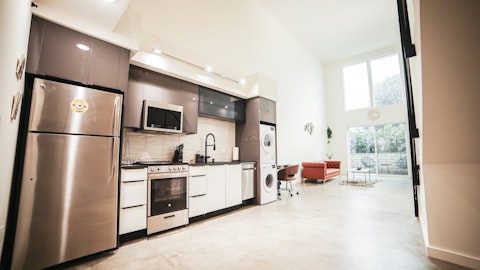There will be more to come as we continue to curate our assortment in the remainder of 2022 and into 2023. We know that our customers will shop us when they see a great deal and are thrilled about our assortment. I’m pleased with the progress we’ve made on both fronts. Looking at specific category performance in the quarter, seasonal comps grew strongly, up 7% in Q3 fueled in part by heavy promotions. Halloween items were up about 30%, driven by items such as a nine foot tall witch, skeletons carrying a coffin in an animated witch’s broom. We have leveraged our insights into consumer behavior and factored them into the Q4 holiday season. For example, we saw continued strength in outdoor decor and desire from consumers to celebrate a holiday.
As a result, we have placed some of our bigger buys in Christmas trees and outdoor décor, while reducing our buys on indoor decor this holiday season. Our food category was up 1% and the consumables category was down 5% in Q3 with renewed strength in beverage, seasonal food items, and paper. Furniture soft home and hard home categories were down double-digits as they continue to be impacted by consumers delaying or cutting back on higher ticket purchases. We have been addressing this through introducing lower opening price points especially in furniture and more bargains in our store, and we expect these efforts to gain more traction over the coming quarters. The lot apparel and electronics were down 4%. The lot and apparel items drive a lot of excitement in our stores and showcase some of our newest items and best deals.
As we progress into the fourth quarter, the lower opening price points great bargain’s and fund treasures and more productive essentials will help drive sales momentum. That said, we have seen significant pressure in the market environment, particularly in higher ticket discretionary items. So we do not expect a significant change in the comp sales momentum in Q4 relative to Q3. Therefore, we expect comps to remain in the down low double-digit range in the fourth quarter. With regard to gross margin, it will be sequentially higher versus Q3 in the mid-30s range, which is inclusive of additional markdowns related to accelerate store closures and efforts to clean up slow moving inventory. And we continue to expect to end the year with a healthy inventory position, which will be flat to down year-over-year.
I’d now like to talk about how we’re navigating the current environment and creating opportunities to strengthen our business. We remain laser focused on actions that enable us to better adapt to continuously evolving customer needs, build upon core competencies and deliver incredible value. I’ll provide a few examples of these activities. First, we will own bargains and treasures. Our company was built on providing phenomenal value and we’re leaning into it in a much bigger way. Customers come to our stores for great deals and exciting products, and we simply haven’t had enough of these. So we’re accelerating our efforts to optimize and differentiate our assortment with more bargains and treasures. By the end of 2023, our assortment will be two-thirds bargains and treasures, up from the high 40% range today.
Bargains are expected to be one-third of the assortment, up significantly from mid single-digit penetration in 2022. Bargains and treasures will bring more excitement to our assortment and will ultimately increase new customer growth and loyalty. Second, we will communicate unmistakable value. We’ve done a great job in sourcing bargains and growing their value based private brands such as Broyhill and Real Living, but we have not done a good job communicating and curating our incredible value offers to make it an easy and compelling shop for our customers. This means we will better communicate value and make it easier for customers to shop our stores. We don’t want our customers to have to wonder if they’re getting a better deal and somewhere else.
So we will do this through clear value messaging that will communicate unmistakable, comparable value in everything we do. We’ll do this by having ticketing and marketing that is clearer than ever before. For example, we have simplified the end caps and focused more on bargains and treasures rather than essentials. By October, nearly 90% of our end caps were focused on bargains and treasures versus 40% in July. In January, we are going to introduce comparable value pricing tags to showcase our value offers more and to make the shopping experience even better. These efforts are designed to drive customer trial, frequency and loyalty. We’re also well positioned to provide value as a trade down destination. Our private brands, especially Broyhill, will play a key role in increasing our appeal.
Both Broyhill and Real Living continue to do well with sales growth of around 10% at each brand. Across all divisions, these brands represented 30% of our business in Q3, up from the mid-20s last year. Recall that our seasonal customer has a household income that is two times higher than our core customer. So we see that category as a year round trade down opportunity. We have 38,000 associates, who are value creators and will bring these efforts to life. Our associates play to win and maintain an obsession with the customer, which has led to a very positive customer feedback. We’ve achieved a net promoter score in the 80% range in Q3, which is top tier in the industry and over 20 million customers have rewarded us with their loyalty. We will continue to focus on earning their business each and every day.
Third, we will increasingly focus on rural and small town markets where we know we outperform with our strong assortment of furniture and home goods, while taking a prudent near-term approach to opening stores. Overall, new stores continued to perform with strong performance in rural and small town markets. In these markets, we face less direct competition in our home categories and have a lower cost structure. Therefore, these typically generate more cash and profitability than urban stores. As we think about our real estate strategy in store openings and closings in the future, we see an opportunity to reshape our store portfolio more towards these rural and small town markets with an emphasis on furniture and home goods. Fourth, we will win with omnichannel.





